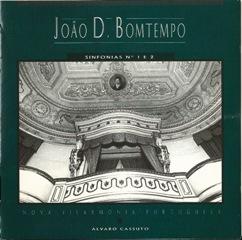Bomtempo – Symphonies Nos. 1 & 2 (Cassuto) [1996]
Bomtempo – Symphonies Nos. 1 & 2 (Cassuto) [1996]

Symphony No. 1, Op. 11 1. I. Largo - Allegro vivace 2. II. Minuetto 3. III. Andante sostenuto 4. IV. Presto Symphony No. 2 5. I. Sostenuto - Allegro moderato 6. II. Allegretto 7. III. Minetto: Allegro 8. IV. Allegro Nova Filarmonia Portuguesa Álvaro Cassuto – conductor
This CD is a wonderful surprise, a real discovery! Bomtempo is an unknown composer, and this disc contains two of his symphonies, one compact written about 1810, and the second written about 1820, much more extended and developed in form, harmony, and orchestration, lasting 42 minutes. While he is sometimes called the “Portuguese Beethoven”, stylistically his writing is much closer to Schubert in harmony and melody (although it’s very doubtful he ever heard a Schubert symphony). His orchestration owes much to Muzio Clementi, with whom he became associated during his time in London, and who became his publisher. Very noteworthy is Bomtempo’s use of trombones in the second symphony, something unusual in symphonic writing at this time, but Clementi had used trombones in all his last four symphonies, also written at the same time as Bomtempo’s No.2. The liner notes suggest the influence of Beethoven’s sixth symphony (the first time he used trombones in a symphony) but the influence of Clementi is much more pronounced – even though Bomtempo writes scherzo movements he still labels them “minuetto”, which Clementi also does. And the minuetto of the second symphony is modeled on a “Menuetto Pastorale” of Clementi that exists as a separate composition. But the music – oh, what music! Bomtempo’s music is heavily based on Portuguese folk dance rhythms -- he must have been a very good dancer! Especially in the second symphony, dance rhythms predominate, and the last movement is based on what seems to be the Portuguese dance foclore, with a one-two-three, one-two-three, tuurrn, tuurrn rhythm over and over. I’m no expert in Portuguese dances, but a friend was born there, and his description of this dance matches the music perfectly. The Algarve Orchestra, based in Southern Portugal, relishes this music, and plays it perfectly – you can sense that they are dancing in their places even as they play! Even though they are a newly-founded orchestra, their playing is absolutely first-rate, and is one of the special features of this recording. --- Catriel Blum, amazon.com
download (mp3 @320 kbs):
uploaded yandex 4shared mediafire mega solidfiles zalivalka cloudmailru filecloudio oboom








